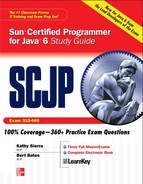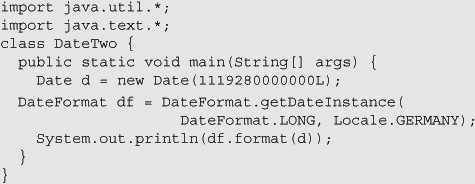![]() Study the d, s, w, and. metacharacters
Study the d, s, w, and. metacharacters
![]() regex provides for quantifiers which allow you to specify concepts like: "look for one or more digits in a row."
regex provides for quantifiers which allow you to specify concepts like: "look for one or more digits in a row."
![]() Study the ?, *, and + greedy quantifiers.
Study the ?, *, and + greedy quantifiers.
![]() Remember that metacharacters and Strings don't mix well unless you remember to "escape" them properly. For instance String s = "\d";
Remember that metacharacters and Strings don't mix well unless you remember to "escape" them properly. For instance String s = "\d";
![]() The Pattern and Matcher classes have Java's most powerful regex capabilities.
The Pattern and Matcher classes have Java's most powerful regex capabilities.
![]() You should understand the Pattern compile() method and the Matcher matches(), pattern(), find(), start(), and group() methods
You should understand the Pattern compile() method and the Matcher matches(), pattern(), find(), start(), and group() methods
![]() You WON'T need to understand Matcher's replacement-oriented methods.
You WON'T need to understand Matcher's replacement-oriented methods.
![]() You can use java.util.Scanner to do simple regex searches, but it is primarily intended for tokenizing.
You can use java.util.Scanner to do simple regex searches, but it is primarily intended for tokenizing.
![]() Tokenizing is the process of splitting delimited data into small pieces.
Tokenizing is the process of splitting delimited data into small pieces.
![]() In tokenizing, the data you want is called tokens, and the strings that separate the tokens are called delimiters.
In tokenizing, the data you want is called tokens, and the strings that separate the tokens are called delimiters.
![]() Tokenizing can be done with the Scanner class, or with String.split().
Tokenizing can be done with the Scanner class, or with String.split().
![]() Delimiters are single characters like commas, or complex regex expressions.
Delimiters are single characters like commas, or complex regex expressions.
![]() The Scanner class allows you to tokenize data from within a loop, which allows you to stop whenever you want to.
The Scanner class allows you to tokenize data from within a loop, which allows you to stop whenever you want to.
![]() The Scanner class allows you to tokenize Strings or streams or files.
The Scanner class allows you to tokenize Strings or streams or files.
![]() The String.split() method tokenizes the entire source data all at once, so large amounts of data can be quite slow to process.
The String.split() method tokenizes the entire source data all at once, so large amounts of data can be quite slow to process.
![]() New to Java 5 are two methods used to format data for output. These methods are format() and printf(). These methods are found in the PrintStream class, an instance of which is the out in System.out.
New to Java 5 are two methods used to format data for output. These methods are format() and printf(). These methods are found in the PrintStream class, an instance of which is the out in System.out.
![]() The format() and printf() methods have identical functionality.
The format() and printf() methods have identical functionality.
![]() Formatting data with printf() (or format()) is accomplished using formatting strings that are associated with primitive or string arguments.
Formatting data with printf() (or format()) is accomplished using formatting strings that are associated with primitive or string arguments.
![]() The format() method allows you to mix literals in with your format strings.
The format() method allows you to mix literals in with your format strings.
![]() The format string values you should know are
The format string values you should know are
![]() Flags: -, +, 0, ",", and (
Flags: -, +, 0, ",", and (
![]() Conversions: b, c, d, f, and s
Conversions: b, c, d, f, and s
![]() If your conversion character doesn't match your argument type, an exception will be thrown
If your conversion character doesn't match your argument type, an exception will be thrown
SELF TEST
1. Given:
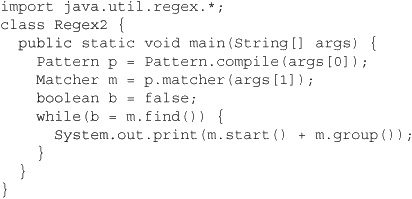
And the command line:
![]()
What is the result?
A. 234
B. 334
C. 2334
D. 0123456
E. 01234456
F. 12334567
G. Compilation fails
2. Given:
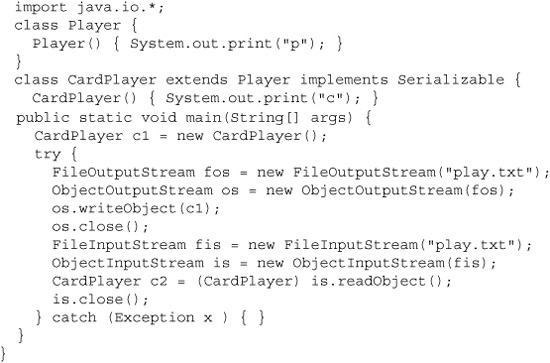
A. pc
B. pcc
C. pcp
D. pcpc
E. Compilation fails
F. An exception is thrown at runtime
3. Given:

Which of the following will be included in the output String s? (Choose all that apply.)
A. .e1
B. .e2
C. =s
D. fly
E. None of the above
F. Compilation fails
G. An exception is thrown at runtime
4. Given:
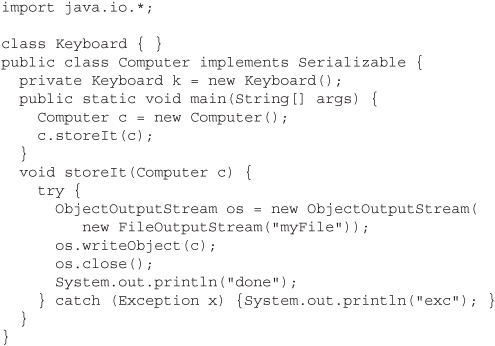
What is the result? (Choose all that apply.)
A. exc
B. done
C. Compilation fails
D. Exactly one object is serialized
E. Exactly two objects are serialized
5. Using the fewest fragments possible (and filling the fewest slots possible), complete the code below so that the class builds a directory named "dir3" and creates a file named "file3" inside "dir3'. Note you can use each fragment either zero or one times
Code:

Fragments:

6. Given that 1119280000000L is roughly the number of milliseconds from Jan 1, 1970, to June 20, 2005, and that you want to print that date in German, using the LONG style such that "June" will be displayed as "Juni', complete the code using the fragments below. Note: you can use each fragment either zero or one times, and you might not need to fill all of the slots
Code:

Fragments:

7. Given:

and that the invocation
![]()
is issued from a directory that has two subdirectories, " dir1" and " dir2", and that " dir1" has a file " file1.txt" and " dir2" has a file " file2.txt", and the output is " false true" ; which set(s) of code fragments must be inserted? (Choose all that apply.)

8. Given:

Which are true? (Choose all that apply.)
A. Compilation fails
B. The output is 10 0 9
C. The output is 10 0 10
D. The output is 10 7 9
E. The output is 10 7 10
F. In order to alter the standard deserialization process you would implement the readObject() method in method in SpecialSerial
G. In order to alter the standard deserialization process you would implement the defaultReadObject() method in SpecialSerial
9. Given:

Which are true? (Choose all that apply.)
A. Compilation fails
B. The first line of output is abc abc true
C. The first line of output is abc abc false
D. The first line of output is abcd abc false
E. The second line of output is abcd abc false
F. The second line of output is abcd abcd true
G. The second line of output is abcd abcd false
10. Given:

And given that myfile.txt contains the following two lines of data:
![]()
What is the result?
A. ab
B. abcd
C. ab
cd
D. a
b
c
d
E. Compilation fails
11. Given:

If line 6 creates a valid Console object, and if the user enters fred as a username and 1234 as a password, what is the result? (Choose all that apply.)
A. username:
password:
B. username: fred
password:
C. username: fred
password: 1234
D. Compilation fails
E. An exception is thrown at runtime
12. Given:

Instances of which class(es) can be serialized? (Choose all that apply.)
A. Car
B. Ford
C. Dodge
D. Wheels
E. Vehicle
13. Given:

Which are true? (Choose all that apply.)
A. The output is 987.12345 987.12345
B. The output is 987.12346 987.12345
C. The output is 987.12345 987.123456
D. The output is 987.12346 987.123456
E. The try/catch block is unnecessary
F. The code compiles and runs without exception
G. The invocation of parse() must be placed within a try/catch block
14. Given:

And given the command line invocation:
![]()
What is the result?
A. 0
B. 3
C. 4
D. 8
E. 9
F. Compilation fails
15. Given:

What is the result?
A. 1 2
B. 1 2 3 45 6
C. 1 2 3 4 5 6
D. 1 2 a 3 45 6
E. Compilation fails
F. 1 2 followed by an exception
SELF TEST ANSWERS
1. Given:

And the command line:
![]()
What is the result?
A. 234
B. 334
C. 2334
D. 0123456
E. 01234456
F. 12334567
G. Compilation fails
Answer: |
|
|
|
|
2. Given:
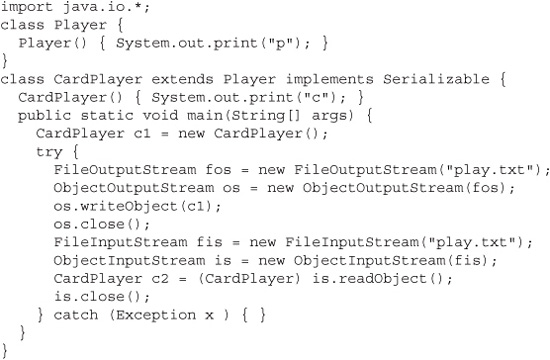
What is the result?
A. pc
B. pcc
C. pcp
D. pcpc
E. Compilation fails
F. An exception is thrown at runtime
Answer: |
|
|
3. Given:
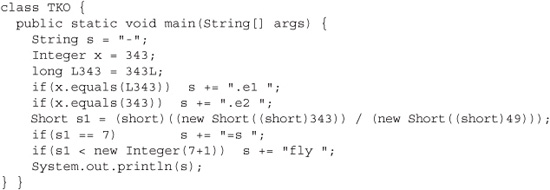
Which of the following will be included in the output String s? (Choose all that apply.)
A. .e1
B. .e2
C. =s
D. fly
E. None of the above
F. Compilation fails
G. An exception is thrown at runtime
Answer: |
|
|
|
|
4. Given:
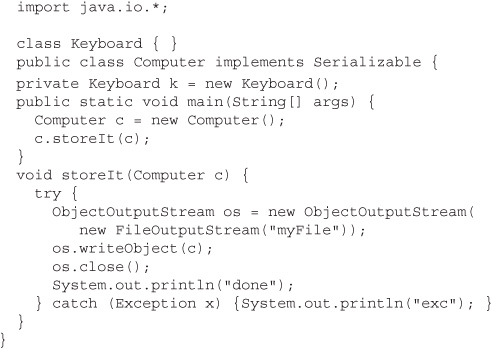
What is the result? (Choose all that apply.)
A. exc
B. done
C. Compilation fails
D. Exactly one object is serialized
E. Exactly two objects are serialized
Answer: |
|
|
|
|
5. Using the fewest fragments possible (and filling the fewest slots possible), complete the code below so that the class builds a directory named " dir3" and creates a file named " file3" inside " dir3". Note you can use each fragment either zero or one times.
Code:
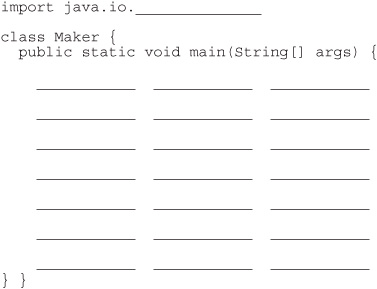
Fragments:

Answer: |
|
|
|
|
Notes: The new File statements don't make actual files or directories, just objects. You need the mkdir() and createNewFile() methods to actually create the directory and the file. (Objective 3.2) |
6. Given that 1119280000000L is roughly the number of milliseconds from Jan. 1, 1970, to June 20, 2005, and that you want to print that date in German, using the LONG style such that "June" will be displayed as "Juni', complete the code using the fragments below. Note: you can use each fragment either zero or one times, and you might not need to fill all of the slots.
Code:
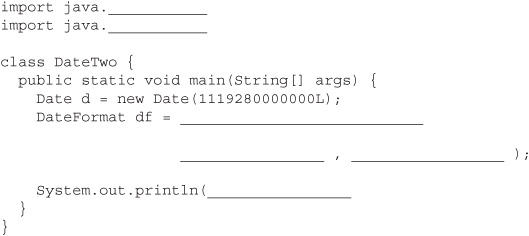
Fragments:

7. Given:

and that the invocation
![]()
is issued from a directory that has two subdirectories, "dir1" and "dir2", and that "dir1" has a file "file1.txt" and "dir2" has a file "file2.txt', and the output is "false true', which set(s) of code fragments must be inserted? (Choose all that apply.)
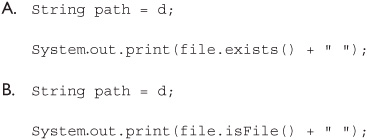
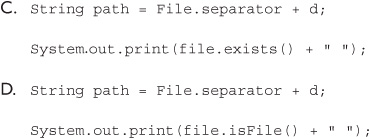
Answer: |
|
|
|
|
8. Given:

Which are true? (Choose all that apply.)
A. Compilation fails
B. The output is 10 0 9
C. The output is 10 0 10
D. The output is 10 7 9
E. The output is 10 7 10
F. In order to alter the standard deserialization process you would implement the readObject() method in method in SpecialSerial
G. In order to alter the standard deserialization process you would implement the defaultReadObject() method in SpecialSerial
Answer: |
|
|
|
|
9. Given:
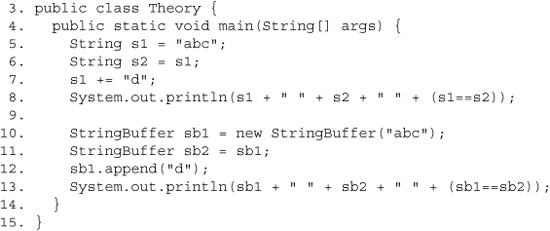
Which are true? (Choose all that apply.)
A. Compilation fails
B. The first line of output is abc abc true
C. The first line of output is abc abc false
D. The first line of output is abcd abc false
E. The second line of output is abcd abc false
F. The second line of output is abcd abcd true
G. The second line of output is abcd abcd false
Answer: |
|
|
|
|
10. Given:

And given that myfile.txt contains the following two lines of data:
ab
cd
What is the result?
A. ab
B. abcd
C. ab
cd
D. a
b
c
d
E. Compilation fails
Answer: |
|
|
|
|
11. Given:

If line 6 creates a valid Console object, and if the user enters fred as a username and 1234 as a password, what is the result? (Choose all that apply.)
A. username:
password:
B. username: fred
password:
C. username: fred
password: 1234
D. Compilation fails
E. An exception is thrown at runtime
Answer: |
|
|
|
|
12. Given:

Instances of which class(es) can be serialized? (Choose all that apply.)
A. Car
B. Ford
C. Dodge
D. Wheels
E. Vehicle
Answer: |
|
|
|
|
13. Given:

Which are true? (Choose all that apply.)
A. The output is 987.12345 987.12345
B. The output is 987.12346 987.12345
C. The output is 987.12345 987.123456
D. The output is 987.12346 987.123456
E. The try/catch block is unnecessary
F. The code compiles and runs without exception
G. The invocation of parse() must be placed within a try/catch block
Answer: |
|
|
|
|
14. Given:
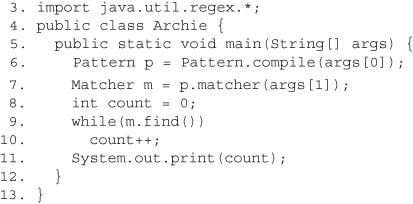
And given the command line invocation:
![]()
What is the result?
A. 0
B. 3
C. 4
D. 8
E. 9
F. Compilation fails
Answer: |
|
|
|
|
15. Given:

What is the result?
A. 1 2
B. 1 2 3 45 6
C. 1 2 3 4 5 6
D. 1 2 a 3 45 6
E. Compilation fails
F. 1 2 followed by an exception
Answer: |
|
|
|
|
